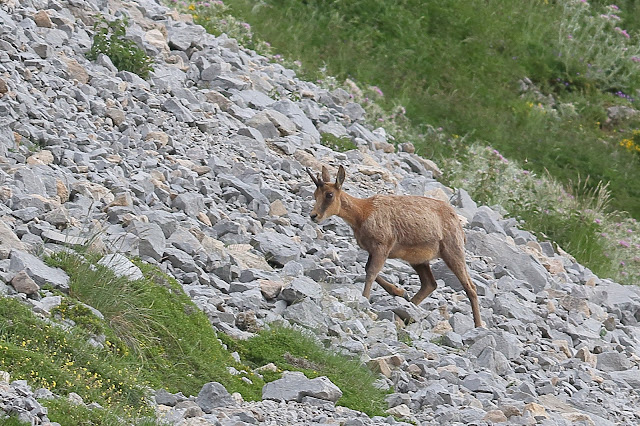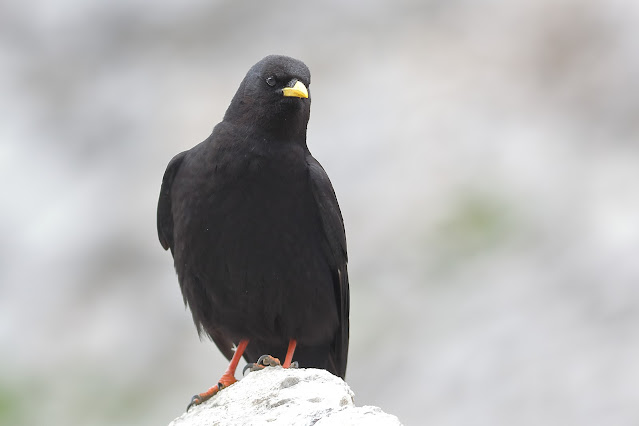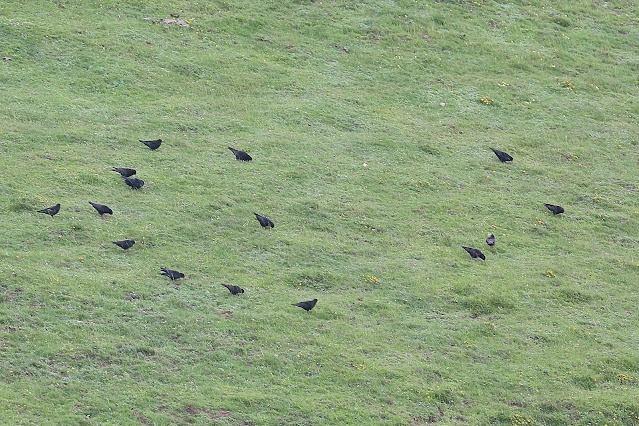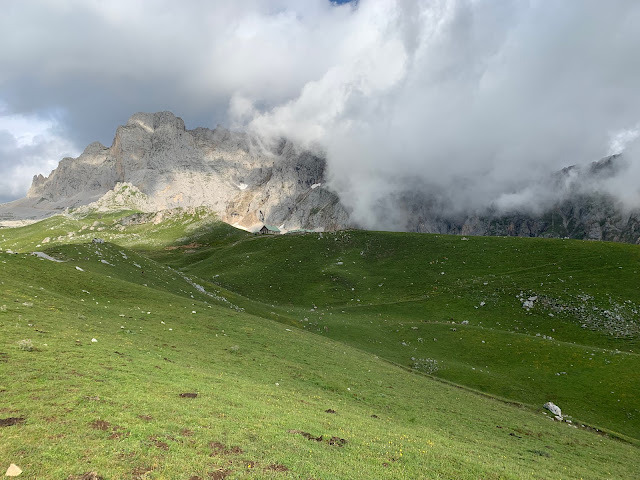Hola una vez más.
Hi again.
Hi again.
En el siguiente enlace podéis ver nuestros próximos viajes fotográficos y de observación de aves y mamíferos nacionales y al extranjero. Espero que os gusten y os animéis a venir conmigo. Una experiencia que nunca olvidareis.
In the following link you can see our next national and foreign Birds and Mammals photographic and observation trips. I hope you like them and I encourage you to come with me. An experience that you will not forget.
En este blog os enseño lo que pude ver y fotografiar en mi viaje programado a Picos de Europa del 18 al 20 de junio. El tiempo estuvo regular pues nos llovio algo, una tarde hizo mucho viento y por la noche estuvo nublado por lo que no disfrutamos de la vía láctea.
In this post I show you what I was able to spot and photograph on my scheduled trip to Picos de Europa from June 18 to 20. The weather was so so because it rained a little, one afternoon it was very windy and at night it was cloudy so we did not enjoy the milky way.
Os voy a enseñar lo que vimos por los días en los que los vimos.
I am going to show you what we saw for the days in which we saw them.
I am going to show you what we saw for the days in which we saw them.
DOMINGO 18:
SUNDAY 18:
SUNDAY 18:
Llegamos a la hora de comer y como no llovía salimos a darnos un paseo. En la foto el Hotel Áliva donde nos alojamos las dos noches.
We arrived at lunchtime and since it was not raining we went out for a walk. In the photo the Hotel Áliva where we stayed the two nights.
Además de ser un destino para ver aves, la belleza de los paisajes es espectacular.
In addition to being a destination for bird watching, the beauty of the landscapes is awesome.
La mayoría de las aves que vimos estaban alimentando a sus polluelos. En la foto un macho de collalba gris (Oenanthe
oenanthe).
Most of the birds we saw were feeding their chicks. In the photo a male Northern
Wheatear.
Un macho de bisbita alpino (Anthus
spinoletta).
A male Water Pipit.
Chova piquirroja (Pyrrhocorax
pyrrhocorax).
Red-billed
Chough.
Este año vimos muchos gorriones alpinos (Montifringilla
nivalis). Algunas parejas ya iban con sus pollos volantones.
This year we saw a lot of Snowfinch. Some couples were already going with their fledglings.
Colirrojo tizón (Phoenicurus
ochruros) macho.
A male Black
Redstart.
LUNES 19:
MONDAY 19:
Vista desde el Hotel de Peña Vieja de 2613 metros de altitud con el chalet Real debajo.
View from the Hotel of Peña Vieja of 2613 meters above sea level with the Chalet Real below.
Camino hacia el teleférico. Este año lo estaban revisando y no subía público en él lo que fue una maravilla pues estábamos solos paseando por los senderos.
I walk towards the cable car. This year they were reviewing it and no public got on it which was wonderful because we were alone walking through trails.
Uno de los clientes fotografiando una chova piquigualda (Pyrrhocorax
graculus). Siempre me llama la atención lo mansas que son en Picos de Europa.
One of the clients photographing a Yellow-billed Chough. It always strikes me how tame they are in the Picos de Europa.
Camino de Peña Vieja.
Peña Vieja trail.
El pico mas alto es la torre del LLambrión de 2642 metros de altitud.
The highest peak is the Torre del LLambrión, 2642 meters high.
Vista de Fuente Dé desde la cafetería superior del teleférico.
View of Fuente Dé from the upper cafeteria of the cable car.
Antes de salir de excursión vimos un grupo de buitres leonados (Gyps
fulvus) que vinieron a comerse un placenta de una vaca que había parido por la noche.
Before going on the excursion we saw a group of Griffon Vultures that came to eat a placenta from a cow that had calved at night.
Fue muy poca comida para tanto buitre y al ver tanto ajetreo vino también una pareja de alimoche común (Neophron
percnopterus).
There was very little food for so many Griffon Vultures and seeing so much hustle and bustle a pair of Egyptian Vultures also came.
Pero cuando se posaron, ya no quedaba nada para ellos.
But when they landed, there was nothing left for them.
En el camino de ida para ver si éramos capaces de avistar algún treparriscos (Tichodroma
muraria) pronto empezamos a ver las primaras collalbas grises (Oenanthe
oenanthe) que estaban cogiendo insectos par cebar a sus crías. En la foto una hembra.
On the trail to see if we were able to spot any Wallcreepers we soon began to see the first Northern Wheatear that were catching insects to feed their chicks. In the photo a female.
En este viaje la suerte no estuvo de nuestro lado y no pudimos ver ningún treparriscos Tichodroma muraria). Este ha sido el único viaje a Picos de Europa en el que no lo hemos visto.
On this trip luck was not on our side and we could not see any wallcreepers (Tichodroma muraria). This has been the only trip to Picos de Europa in which we have not seen it.
Muy cerca del Hotel, había una pareja de gorriones alpinos (Montifringilla
nivalis) que habían construido su noido y estaba cebando a sus pollos que ya estaban a punto de echarse a volar.
Very close to the Hotel, there was a pair of alpine sparrows (Montifringilla nivalis) that had built their nest and were feeding their chicks that were about to fledge.
Un bonito macho de pardillo común (Linaria
cannabina).
A beautiful male Common Linnet.
Hembra.
Female.
Un ejemplar adulto de halcón peregrino (Falco
peregrinus).
An adult peregrine falcon.
Cuando se posó, era como si ya no hubiese nada. Pero aunque difícil de localizar, allí estaba posado.
When it landed, it was as if there was nothing anymore. But although difficult to locate, it was perched there.
He ampliado un poco la foto y marcado en amarillo donde estaba el halcón pues reconozco que no es fácil verle.
I have enlarged the photo a little and marked in yellow where the Peregine Falcon was because I recognize that it is not easy to see it.
Algunos gorriones alpinos (Montifringilla
nivalis) buscando alimento.
Some Snowfinches searching for food.
Un joven de colirrojo tizón recién salido del nido esperando a que uno de sus padres le trajera alimento (Phoenicurus
ochruros).
A a freshly fledge Black Redstart waiting for a parent to bring it food.
También las flores que puedes ver en estos altos parajes son muy bonitas. Esta pertenece al género de los Helianthemum.
Flowers that you can see in these high places are also very beautiful. This belongs to the genus Helianthemum.
Siempreniña (Erinus alpinus).
Fairy Foxglove.
Palomilla alpina (Linaria alpina).
Alpine Toadflax.
Una llamativa gentiana (Gentiana acaulis).
A showy Trompet Gentian.
Globularia menor (Globularia cordifolia).
Blue Puff Globe Daisy.
Un halcón peregrino (Falco peregrinus) estaba siendo hostigado por unas chovas piquirrojas (Pyrrhocorax
pyrrhocorax). Me imagino que el halcón no estaba de caza pues de otra forma la chova estaría en graves aprietos.
A Peregrine Falcon was being harassed by Red-billed Choughs. I imagine that the Peregrine Falcon was not hunting because otherwise the Red-billed Chough would be in serious trouble.
Estos fueron los gorriones alpinos (Montifringilla
nivalis) que más cerca tuvimos.
These were the Snowfinches that we were closest to.
Al no haber gente que subía en el teleférico, vimos bastantes rebecos cantábricos (Rupicapra pyrenaica).
As there were no people riding the Cable Car, we saw quite a few Cantabrian Chamois.
Este año vimos menos acentores alpinos (Prunella
collaris) que en otros años.
This year we saw fewer Alpine Accentors than in other years.
Que bonitos son.
How beautiful they are.Tuvimos la suerte de poder contemplar a un quebrantahuesos (Gypaetus
barbatus) de los liberados en el proyecto LIFE Pro Quebrantahuesos. Como podéis ver estaba marcado con el número 1 (x).
We were lucky to be able to see a Bearded Vulture of those released in the LIFE Pro Quebrantahuesos Project. As you can see it was marked with the number 1 (x).
Fue en 2010 cuando se reintrodujeron los primeros nuevos ejemplares y en 2020 cuando se produjo la primera reproducción exitosa. En la actualidad hay ya 28 ejemplares.
It was in 2010 when the first new specimens were reintroduced and in 2020 when the first successful reproduction occurred. Currently there are already 28 specimens.
Mientras esperábamos a ver si veíamos treparriscos (Tichodroma
muraria) las chovas piquigualdas (Pyrrhocorax
graculus) vinieron a hacernos la espera más entretenida.
While we waited to see if we could spot Wallcreeper, Yellow-billed Choughs came to make our wait more amusing.
Esta pareja de acentores alpinos (Prunella
collaris) estaban alimentando a sus pollos en un nido que tenían en un hueco de la pared rocosa.
This pair of Alpine Accentors were feeding their chicks in a nest they had in a hole in the rock face.
En el teleférico vimos a un joven de acentor alpino (Prunella collaris).
On the Cable Car we saw a juvenile Alpine Accentor.
Cerca de allí vimos a un grupo de gorriones alpinos (Montifringilla
nivalis) que estaban cebando a sus pollos volantones. Eran varia parejas con sus pollos.
Nearby, we saw a group of Snowfinches feeding their fledglings. They were several couples with their chicks.
Uno de los jóvenes. Fijaos que tiene menos blanco y el pico amarillento.
One of the juvenile. Notice that it has less white and a yellowish beak.
Un macho ce colirrojo tozón (Phoenicurus
ochruros).
A male Black
Redstart.
Todo el mundo estaba cebando a sus polluelos. En la foto una hembra de collalba gris (Oenanthe
oenanthe).
Everyone was feeding their chicks. In the photo a female Northern
Wheatear.
Chova piquigualda (Pyrrhocorax
graculus).
Yellow-billed
Chough.
Vimos muy pocos cuervos grandes (Corvus corax).
We saw very few Common
Raven.
Cuando regresábamos al hotel volvimos a ver rebecos cantábricos (Rupicapra pyrenaica).
When we were returning to the hotel we saw Cantabrian Chamois again.
Y a un grupo de chovas piquirrojas (Pyrrhocorax
pyrrhocorax).
And a flock of Red-billed
Chough.
MARTES 20:
TUESDAY 20:
El último día del viaje bajamos a la zona limítrofe con el bosque y donde los ganaderos dejan los pastos crecer para luego hacer heno poder tener alimento para el ganado durante el invierno. Vista del hotel y Peña Vieja.
The last day of the trip we went down to the area bordering the forest and where the ranchers let the grass grow and then make hay to feed cattle in winter. View of the Hotel and Peña Vieja.
Algunas fotos durante la bajada.
Some photos during the descent.
Los invernales de Igüedri.
Wintry of Igüedri.
Chova piquirroja (Pyrrhocorax
pyrrhocorax).
Red-billed
Chough.
Un busardo ratonero (Buteo buteo).
A Common Buzzard.
Vimos varios buitres leonados (Gyps
fulvus).
We saw several Griffon Vultures.
Esta madre y su potrillo llamaron mi atención al ser caballos apalusa.
This mother and her foal caught my attention as Appaloosa Horses.
Un joven de collalba gris (Oenanthe
oenanthe).
A juvenile Northern
Wheatear.
Este macho de roquero rojo (Monticola
saxatilis) estaba cantando a nuestro paso cerca suyo.
This male Rufous-tailed
Rock Thrush was singing as we passed close to him.
Mucho mejor cuando se puso con buena luz.
Much better when he put in good light.
Una bonita orquídea Lagarto (Himantoglossum hircinum).
A beautifull Lizard Orchid.
Los machos de pardillo común (Linaria cannabina) estaban preciosos.
Common Linnet males (Linaria cannabina) were beautiful.
Acentor común (Prunella
modularis).
Dunnock.
Enseguida empezamos a oír y a ver escribanos cerillos (Emberiza
citrinella).
Right away we began to hear and see Yellowhammer.
Al ir mas temprano que otros años, en esta zona de pastos había menos flores que en otros años. En la foto un cardo de almizcle (Carduus nutans).
By going earlier than other years, in this area of pastures there were fewer flowers than in other years. In the photo a Musk Thistle.
Gabardera (Rosa pendulina).
Mountain Rose.
Un macho de alcaudón dorsirrojo (Lanius collurio).
A male Red-backed
Shrike.
Esta hembra de roquero rojo (Monticola
saxatilis) no paraba de cazar insectos para sus pollos.
This female Rufous-tailed
Rock Thrush did not stop hunting insects for her chicks.
En algunos momentos se metía la niebla. En la foto un escribano montesino (Emberiza
cia).
In some moments the fog got in. In the photo a Rock Bunting.
Un macho de tarabilla europea (Saxicola rubicola).
A male Common
Stonechat.
Al final del recorrido pudimos ver más de cerca a los escribanos cerillos (Emberiza
citrinella).
At the end of the trail we got a closer look at the Yellowhammer.
Dedaleraa (Digitalis purpurea).
Common Foxglove.
Gallos (Orobanche gracilis). Es una planta parásita que no tiene clorofila y es dependiente de otras plantas a las que unen sus raíces para tomar agua y nutrientes. Esta especie parasita sobre plantas leguminosas.
Slender Broomrape. It is a parasitic plant that does not have chlorophyll and is dependent on other plants to which they attach their roots to take in water and nutrients. This species parasitizes on leguminous plants.
A este bisbita arbóreo (Anthus
trivialis) le pudimos ver pues reconocí su canto.
We could see this Tree Pipit because I recognized its song.
Y cuando ya estábamos comiendo para comenzar el regreso a Madrid, vimos a este alimoche común (Neophron
percnopterus).
And when we were already eating to start the return to Madrid, we saw this Egyptian Vulture.
En el camino de regreso a Madrid hicimos una parada, que creo es obligatoria, para ver esta joya del románico Palentino. La iglesia de San Juan Bautista.
On the way back to Madrid we made a stop, which I think is mandatory, to see this jewel of the Palencia Romanesque. The church of San Juan Bautista.
Si queréis suscribiros a este blog de los viajes que hacemos pincha en el siguiente enlace: Suscribirse y haz clic en ¿ Quieres suscribirte a nuestro blog?
If you want to subscribe to this post about the trips we do, click on the following link: Susbcribe and click on: Do you want to subscribe to our blog?
Espero que os haya gustado y hasta pronto.
I hope you like it and see you soon.
















































































































No hay comentarios:
Publicar un comentario